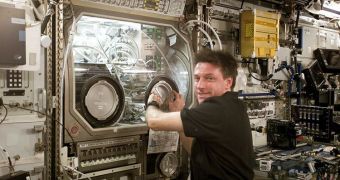According to an announcement officials at the American space agency made on Tuesday, March 20, NASA is currently trying to determine whether it may be possible to use the International Space Station as a microgravity lab for simulating a manned trip to the Red Planet.
Under President Obama's orders, the organization is to attempt to land astronauts on near-Earth objects by 2025, and on the surface of Mars by 2035. The first objective is considerably easier to achieve than the second one, primarily due to the timeframes involved.
It would take at least 18 months for a mission to Mars to return to Earth, assuming that the astronauts spend only a brief period of time actually conducting studies on the surface of our neighboring world.
Last year saw the conclusion of the Mars 500 experiments, which isolated six pseudo-astronauts inside a series of interconnected modules at the Russian Institute for Biomedical Problems, in Moscow. The purpose of the test was to see how the human brain handles prolonged exposure to confined spaces.
The human and technological elements of a future mission to the Red Planet are relatively well understood. What mission planners don't yet know is how being exposed to microgravity for a year and a half will influence human health. There is also the issue of defending against harmful cosmic ray.
NASA is assessing whether the ISS is a viable candidate as a space lab in this regard precisely because it benefits from something laboratories on Earth simply have no access to – microgravity.
“Clearly, in order to be able to explore beyond low-Earth orbit, we're going to have to stay in orbit for longer than six months,” NASA official Mike Suffredini, the ISS program manager, said during a conference yesterday.
At this point, efforts to simulate space travel are underway on many fronts and locations around the world, ranging from a lab underneath the waters off Florida Keys, in the United States, to the frigid plains of Antarctica and the barren deserts of Chile.
The effort is however very complex through its very nature. Therefore, mission planners admit that they could benefit from any type of advantage they could get their hands on, Space reports.

 14 DAY TRIAL //
14 DAY TRIAL //